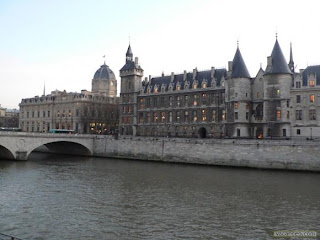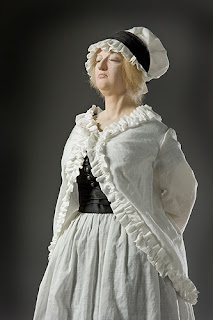>
Her last words were, “Pardon me, sir. I meant not to do it.”
The girl born as the Archduchess of Austria married the man intended for her sister when she was just a wide-eyed teenager and became the Queen of France at eighteen-years-old. She was the toast of Europe for the early years of her reign until the outcry of financial reform, food riots and the mob of revolution changed the face of France. A new nation borne from the sacrificial blood of thousands of aristocrats and the French royal family brought Queen Marie-Antoinette to the guillotine on this day in 1793. Her two surviving children had lost their father to the guillotine in 1792 and were cruelly separated from their mother months before she was executed. Her son, Louis Charles, died in prison and her daughter survived only to enter into a miserable marriage with her cousin and die childless in 1851.
What brought Marie-Antoinette to her lowly condition in her last hours of October 16, 1793? The revolution had reduced her family to the name Capet from Louis’ ancestry, stripping them of all royal and aristocratic titles. When her husband was executed in 1792, Marie-Antoinette became known by the French people as the Widow Capet, replacing the many names they had given her before, such as The Austrian Woman and Madame Déficit. She wore a simple black dress during her time in prison and, for a time, refused to take food or to exercise because of her devastation.
The trial by the revolutionary tribunal that led to her death was, in reality, a pissing contest with Francis, the Holy Roman Emperor who ruled over Austria at that time. He was Marie-Antoinette’s nephew and the National Convention was betting that she held value to them in hostage negotiations. They moved the Widow Capet to La Conciergerie, part of the Paris courthouse, to show Francis that they were serious about putting her on trial. He did not react the way they had hoped, however. Even though he was her nephew, he was unwilling to risk more for someone that he had never met in his life.
Marie-Antoinette’s trial was a joke at best since she had no time to prepare a defense as the King had for his trial. Many of the charges brought against her were untrue and exaggerated, often sounding like the libels (like tabloids) that had floated around France spreading lies for years about her. Among other charges, she was accused of incest and sexual abuse of her young son, Louis Charles, but those charges were dropped by the time the tribunal went into deliberations. It took an hour for the tribunal to reach a verdict of guilty on four counts of treason and similar charges. Executing such a hated public figure was a great way for the National Convention to gain and maintain support amongst the French people. Basically, there was no reason to keep Marie-Antoinette alive if there was no powerful figure willing to negotiate for her life. If there was no French gain for her life, she had to die. So she was thrown out to the dogs on October 16.
The night before her execution, Marie-Antoinette’s guard was arrested for showing her too much respect in leading her back to her cell from the trial. A woman tried to get her to eat and she managed to swallow a few bites of bouillon but believes there is no use in her eating if she will die in a few hours. She wrote her final letter to her sister-in-law, Madame Elisabeth (click her to read the letter and see images of it), and wrote these words into her prayer book:
This 16th of Oct. at 4:30 in the morning
My God, have mercy on me!
My eyes have no more tears
to weep for you my poor
children; farewell, farewell!Marie Antoinette
They told the former queen that she would not be allowed to wear her mourning gown to her execution. The fear was that she would gain pity and support from the crowds if they saw her as an aging, ill widow, no longer a threat to the French people. Instead, she dressed in her only other gown, a thin white cotton house dress, with a black petticoat and a white cap with black trim. Her hair was cut off in order to expose her neck fully for the guillotine blade. She was taken to the Place de la Révolution and arrived at noon. The entire time, she remained cool, steadfast and calm as the Parisian public hurled insults at her from every direction. As she climbs the platform to the guillotine with her hands bound behind her back, she accidentally steps on the executioner’s foot and tells him, “Pardon me, sir. I meant not to do it.” Those were the last words of the most famous Queen in French history. The blade fell at 12:15 pm.
This figure on the right is a very accurate depiction of the way Marie-Antoinette looked on the morning of her execution. It is believed that she suffered from uterine tumors at the end of her life, almost at age thirty-eight, and the condition had been causing hemorrhaging for some time. I’ve also heard it said that she was suffering from tuberculosis as well but I haven’t seen any evidence to that effect.
This picture on the left is the actual blade from the guillotine that ended her life. The executioner’s name was Henri Sanson and he kept the blade after he committed the unnecessary murder.
For me, Marie-Antoinette’s murder in the French Revolution is a symbol of the thousands of murders, bodily manipulations and grisly spectacles and parades of heads on pikes through the city of Paris. She represents all of the names and faces lost to history, like mine, after I was murdered by the same means for no other reason than looking for scapegoats. She was not a criminal any more than I was or anyone else was either. It is an accepted belief that the world can only change through blood and fire, but when you live it, breathe it, witness it and die by it, and carry those memories into future lifetimes, a blinding light shines on the absurdity and waste of it all. I pray no one else has to die the way we did.


















Leave a Reply